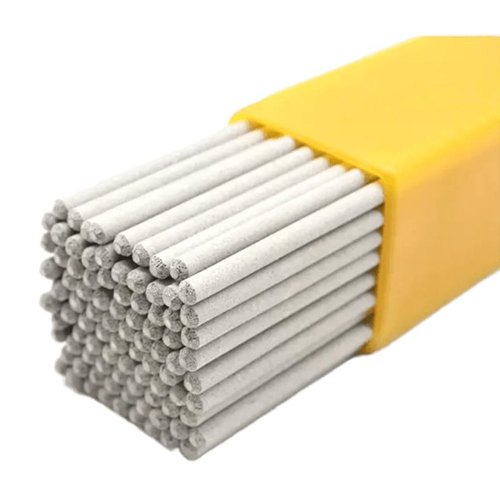CHARACTERISTICS & APPLICATIONS
íshín-312Rx has nominal composition (wt. %) of weld metal 30 Cr, 9 Ni. These electrodes were originally designed to weld cast alloys of similar composition. They have been found to be valuable in welding dissimilar metals, especially if one of them is stainless steel, high in nickel. This alloy gives a two-phase weld deposit with substantial amounts of ferrite in an austenitic matrix. Even with considerable dilution by austenite-forming elements, such as nickel, the microstructure remains two-phase and thus highly resistant to weld metal cracks and fissures. Applications should be limited to service temperature below 420°C to avoid formation of secondary brittle phases.
The covering of these electrodes is a modification of the -16 covering. On horizontal fillet welds, electrodes with a -17 covering tend to produce more of a spray arc and a finer rippled weld-bead surface than do those with the -16 coverings. A slower freezing slag of the -17 covering also permits improved handling characteristics when employing a drag technique. The bead shape on horizontal fillets is typically flat to concave with -17 covered electrodes as compared to flat to slightly convex with -16 covered electrodes. When making fillet welds in the vertical position with upward progression, the slower freezing slag of the -17 covered electrodes requires a slight weave technique to produce the proper bead shape. For this reason, the minimum leg-size fillet that can be properly made with a -17 covered electrode is larger than that for a -16 covered electrode. While these electrodes are designed for all-position operation, electrode sizes 4.8 mm and larger are not recommended for vertical or overhead welding.
Storage and Drying Conditions: Hydrogen can have adverse effects on welds in some steels under certain conditions. One source of this hydrogen is moisture in the electrode coverings. For this reason, the proper storage, treatment, and handling of electrodes are necessary.
Holding Ovens: 125°C–150°C.
Drying Conditions: 250°C–425°C for 1 hour prior to use.
CHEMICAL COMPOSITION OF UNDILUTED WELD
| C | Cr | Ni | Mo | Nb+Ta | Mn | Si | P | S | N | Cu | Others |
| 0.08-0.20 | 25.0-28.0 | 20.0-22.5 | 0.75 | NS | 1.0-2.5 | 1.00 | 0.04 | 0.03 | NS | 0.75 | NS |
Single values are maxima, except where specified otherwise.
ALL-WELD-METAL MECHANICAL PROPERTIES
| Tensile Strength, MPa | Yield Strength, At 0.2% Offset, MPa | Elongation % | Lateral Expansion, mm | Charpy V-Notch Impact at NS°C, Joules |
| 550 | NS | 30 | NS | NS |
Single values are minimal.
ELECTRODE SIZE & WELDING CURRENT (AC and DCEP)
| DIAMETER, mm | LENGTH, mm | Amperes |
| 2.50 | 350 | 65-90 |
| 3.15, 3.20 | 350 | 90-120 |
| 4.00 | 350 | 120-150 |
| 5.00 | 350 | 160-200 |
WARNING: Safety and health information is available from many sources, including, but not limited to Safety and Health Fact Sheets listed in A11.3, ANSI Z49.1 Safety in Welding, Cutting, and Allied Processes published by the American Welding Society, 8669 Doral Blvd., Suite 130, Doral, FL 33166., and applicable federal and state regulations. The Safety and Health Fact Sheets are revised, and additional sheets added periodically.

